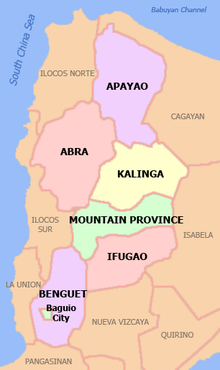![[Flag of the Cordillera People]](http://www.fotw.net/images/p/ph-cpdf.gif) Cordillera Administrative Region Northern Luzon | |
|---|---|
| — Region — | |
| Map of the Philippines showing the location of Cordillera Administrative Region | |
| Country | Philippines |
| Island group | Luzon |
| Regional center | Baguio City |
| Area | |
| - Total | 19,294 km2 (7,449.5 sq mi) |
| Population (2007) | |
| - Total | 1,520,743 |
| - Density | 78.8/km2 (204.1/sq mi) |
| Time zone | PST (UTC+8) |
| Provinces | 6 |
| Cities | 2 |
| Municipalities | 75 |
| Barangays | 1,176 |
| Cong. districts | 7 |
| Languages | Ilokano, Ibaloi, Kankanaey, Kalanguya, Kalinga, Ifugao, Itneg, Isneg, Pangasinan, others |
The Cordillera Administrative Region (CAR) is a region in the Philippines composed of the provinces of Abra, Apayao, Benguet, Ifugao, Kalinga and Mountain Province, as well as Baguio City, the regional center. The Cordillera Administrative Region encompasses most of the areas within the Cordillera Central mountains of Luzon, the largest mountain range in the country. It is the country's only land-locked region. The region is home to numerous indigenous tribes collectively called the Igorot.
Contents[hide] |
[edit] CAR Provinces and Population
CAR is subdivided into 6 provinces and one chartered city, Baguio.
| Province/City | Capital | Population (2007)[1] | Area (km²) | Pop. density (per km²) | |
|---|---|---|---|---|---|
| Abra | Bangued | 230,953 | 3,975.6 | 58.1 | |
| Apayao | Kabugao | 103,633 | 3,927.9 | 26.4 | |
| Benguet | La Trinidad | 372,533 | 2,599.4 | 143.3 | |
| Ifugao | Lagawe | 180,711 | 2,517.8 | 71.8 | |
| Kalinga | Tabuk City | 182,326 | 3,119.7 | 58.4 | |
| Mountain Province | Bontoc | 148,661 | 2,097.3 | 70.9 | |
| Baguio City | — | 301,926 | 57.5 | 5,250.9 | |
¹ Baguio City is a highly urbanized city; figures are excluded from Benguet Province.
[edit] Economy
Cordillera has abundant mineral reserves. These include metallic ores such as gold, copper, silver, zinc, and non-metallic minerals like sand, gravel and sulfur. Mineral reserves are found in all the provinces. However, mining is concentrated in Benguet.
Baguio City and La Trinidad, Benguet are considered as the industrial centers in the region due. In Baguio, you will find an Export Processing Zone where operations of big companies like Texas Instruments, and MOOG are located. In La Trinidad you will find the Provincial Capitol and regional branches of government organizations.
[edit] Tourist attractions
Tourist attractions in the region include the world-famous Banaue Rice Terraces in the province of Ifugao. Nations around the world boast of their own self-proclaimed "eighth wonder of the world." The Philippines considers Banaue Rice Terraces as its "Eighth Wonder of the World." The Banaue terraces, ancient sprawling man-made structures from 2,000 to 6,000 years old, are a UNESCO World Heritage Site. They are part of the Rice Terraces of the Philippine Cordilleras, widely found in the provinces of Apayao, Benguet, Ifugao, Kalinga, and Mountain Province.
Natural attractions of the region include the Sumaguing Cave in Sagada and the mummy caves of Benguet and Mt. Province. There are four National Parks: Cassamata Hill, Mount Pulag, the highest mountain in Luzon, and second highest mountain in the Philippines, following Mount Apo of Davao, with an elevation of 2,922 meters above mean sea level, Mt. Data, and Balbalasang-Balbalan, located in the province of Kalinga. Kalinga also offers world-class white water rafting along the Chico River. The summer capital of the Philippines is Baguio, within the Cordillera Administrative Region.
[edit] Culture
The Cordillera region is known for its unique musical instruments including the gangsa kalinga, nose flute, bamboo flute, buzzer, bangibang, tongatong, diwdiw-as, saggeypo, and bamboo zither.
The region also has various festivals. They include:
Panagbenga / Baguio Flower Festival which is celebrated in February. The festival focuses on Baguio as the Flower Garden City of the North. Highlights include flower exhibits, lectures, garden tours, floral competition and a parade of floats.
Ullalim Festival/ in Kalinga which is celebrated every February 14. It is in celebration of the founding anniversary of the province and the Peace acts called Bodong. It is the poetic expression of the heroic exploits, romance, joys, successes as well as tribulations, and the way of life of the Kalingas from birth to death. The Festival highlights the weaved clothes (laga) exhibits, world class coffee beans and other products of Kalinga.
LANG-AY Festival in Mountain Province celebrated every April 7. This is a week-long agro-industrial trade, tourism and cultural fair with tribal dances and songs. Lang-ay is a native term which describes the tradition of the people of Mountain Province to celebrate festivities, share happiness, foster family solidarity, hospitality and nurture friendship - all with a toast of home-brewed wine.
Banaue Imbayah festival which is celebrated every 4 years. It is a three-day festival from December 5 to 8 consisting of a parade portraying the evolution of the Ifugao culture followed by ethnic games.
Tabuk Matagoan Festival which features G-String marathon (runners wear G-String only), cultural dances and songs. The festival showcases the different products of tabuk coming from the different parts of Kalinga such as the aromatic Kalinga coffee.
(copy of wikipedia)


No comments:
Post a Comment